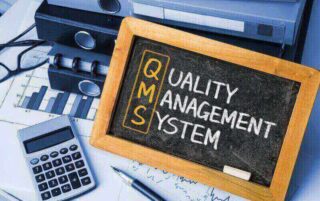Fundamental Elements of a Quality Management System
April 29, 2021

Like so many endeavors, quality management initiatives require that a fundamental set of building blocks be in place in order to be successful. In an earlier post, we talked about eight mandatory elements of a QMS system. That article covered QMS from a functional perspective; in other words, it addressed the specific types of processes that a good QMS system must support.
In this article, we will look at the QMS fundamentals from a different angle, – this time focusing on a more conceptual perspective. Here, we will aim to address the building blocks upon which a strong quality program and a healthy culture of quality can be built. We call these “fundamental elements”, and in that respect, they are truly baseline requirements for good QMS. If any one of the elements on this list is missing or poorly supported in your organization, it can significantly weaken the foundation of your quality program as a whole. In other words, the “chain” of quality is only as strong as its weakest link.
Let’s look at these fundamental elements of a good-quality management system in more detail:
Quality Objectives
Where the organization defines desired outcomes in terms of specific, measurable results. This will often include key metrics around product quality such as the defect rate, customer satisfaction metrics such as the Net Promoter Score (NPS), or measures that indicate a healthy quality culture such as the number of “rejected defects”.
The key is to formulate these objectives in terms that conform to the definition of SMART goals, – that is, specific, measurable, achievable, relevant, and time-bound. Here’s an example:
“By the end of Q4, we will achieve 100% compliance with staff training requirements while maintaining an average assessment score of 90% or higher.”
Clearly defined objectives help to ensure that everyone in your organization is on the same page, and is marching to the same drummer. When you have defined your desired outcomes unambiguously, many of the other elements of quality culture will fall into place more easily. Without clearly defined objectives, however, your quality programs will feel directionless.
Clear roles and responsibilities
On one hand, a healthy quality culture is one in which “quality is everybody’s responsibility.” On the other hand, if accountability and responsibility are not clearly defined and documented, your organization could fall victim to the “everybody, somebody, anybody, nobody” syndrome. An up-to-date organizational chart is essential, as well as a thorough outline of workflows. Very often, the process of documenting roles, responsibilities, and workflows will uncover hidden elements of the process that have not fully been accounted for in quality management practices. In this respect, the process of documenting roles and responsibilities is not merely intended to produce a reference document. Rather, it provides a discovery process that ensures thoroughness throughout the quality management process.
Solid documentation
Should include a quality manual that is thorough, accurate, and up-to-date. We have already mentioned the importance of documenting roles and responsibilities. The process should not end there, however; thorough documentation serves as a valuable go-to resource whenever there is a question as to whether the agreed-upon practices should be. The best quality manuals are ones in which multiple stakeholders have a voice in creating, reviewing, and updating policies and procedures.
Streamlined data-driven processes
Increase the value that quality programs can deliver and provide a firm basis for measuring and communicating that value to decision-makers higher up in the chain of command. An organization must be able to measure results in order to understand whether or not they are achieving the quality objectives that they set out to attain. At the same time, that process must be relatively easy. If processes are too burdensome, – including data collection processes, – then employees may not fully embrace the need to collect such information, and accuracy may suffer as a result. By putting data collection processes into the hands of your employees, – for example, by deploying mobile apps to replace paper-based systems in spreadsheets, you can make the process of collecting information vastly simpler. In addition, those kinds of systems (including Intellect QMS) can be configured to meet your needs without creating unnecessary complexity, workflows can route documents to the appropriate personnel to be processed quickly and efficiently.
Continuous improvement is one of the primary reasons that quality programs exist in the first place. When organizations are committed to a process of continuous improvement and empowered with tools that can help them do the job better, a culture of quality can truly flourish.